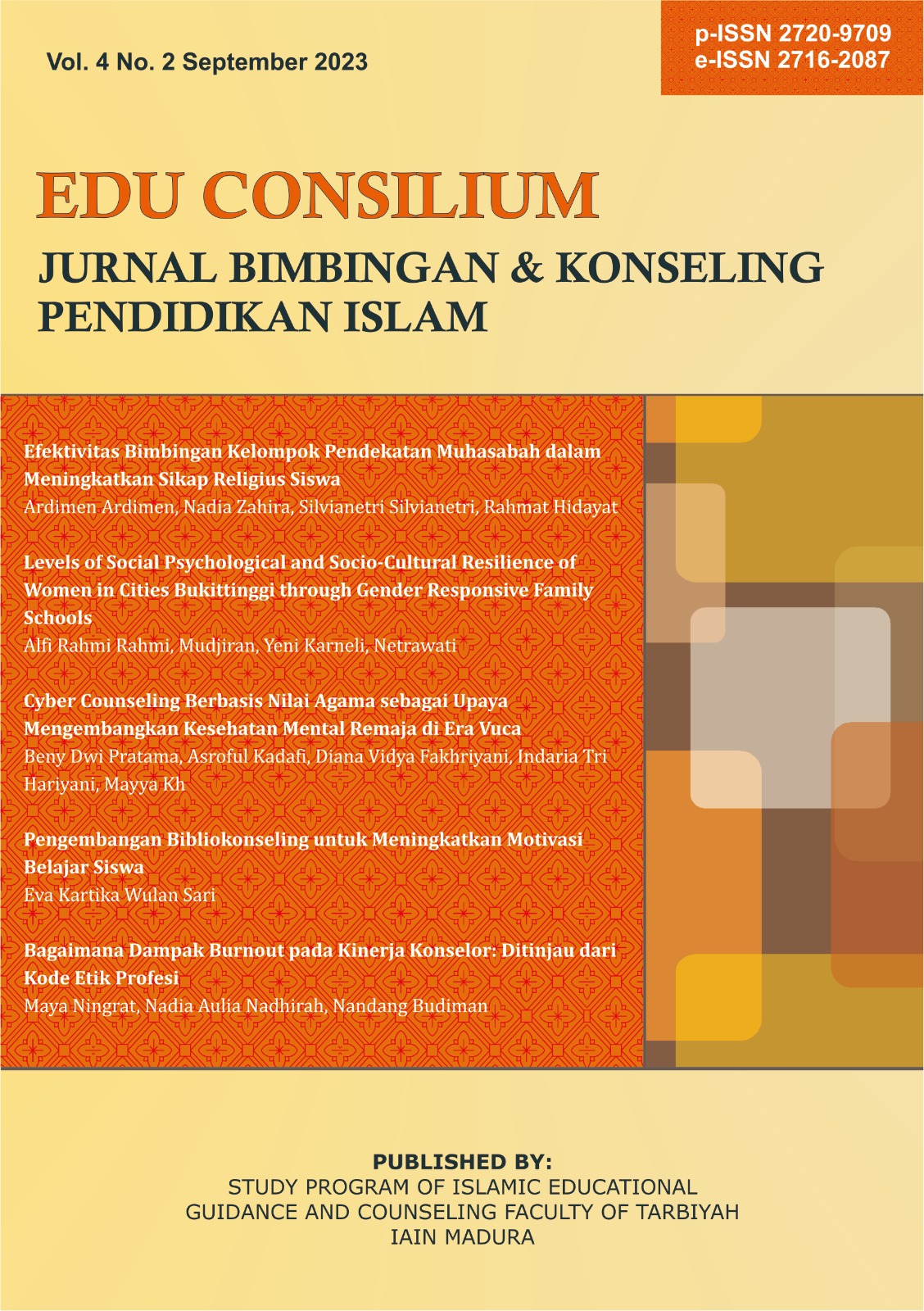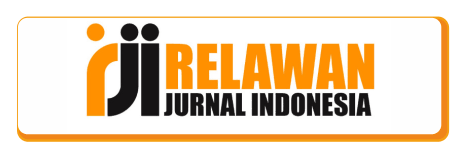Kecenderungan Public Speaking Anxiety pada Mahasiswa
 Abstract views: 1011
,
Abstract views: 1011
,
 PDF downloads: 1246
PDF downloads: 1246
Abstract
The ability to speak in public is very important to be owned and mastered by students so as to produce the right graduate performance in the work environment. The reality on the ground turns out that not a few people are embarrassed to speak in public, causing inappropriate behavior such as experiencing symptoms of public speaking anxiety. This study aims to determine trends in anxiety about speaking in front of general students at the Indonesian University of Education Batch 2021. The research method used was a questionnaire in the form of a package arranged in the form of a Google Form. Data processing in this study used data analysis techniques in the form of descriptive statistical techniques to reveal the level of public speaking anxiety tendencies among students. The results of the descriptive statistical analysis regarding public speaking anxiety of Indonesian University of Education students Class of 2021 with an average score of 76.28 are in the interval 65.5 £ X < 87.1, which is in the medium category.
Downloads
References
Afendy, Yudha, Nurillah. (2020). Hubungan Antara Kesehatan Mental dengan Prokrastinasi Akademik. Antologi Jurnal Bimbingan dan Konseling, Prodi Bimbingan dan Konseling, Fakultas Ilmu Pendidikan, Universitas Pendidikan Indonesia.
Amali, B., & Rahmawati, L. E. (2020). Upaya Meminimalisasi Kecemasan Siswa saat Berbicara di Depan Umum dengan Metode Expressive Writing Therapy. JIPT: Jurnal Ilmiah Psikologi Terapan, 8(2), 109–118.
Ananda, L. R., & Suprihatin, T. (2019). Hubungan Antara Berpikir Positif dan Efikasi Diri dengan Kecemasan Berbicara di Depan Umum Pada Mahasiswa Unissula The Relationship Between Positive Thinking and Self Efficacy With Public Speaking Anxiety in Unissula Students. The Relationship Between Positive Thingking and Self Efficacy with Public Speaking Anxiety in Unissula Student, 129–136.
Bukhori, B. (2016). Kecemasan Berbicara di Depan Umum Ditinjau dari Kepercayaan Diri dan Keaktifan dalam Organisasi Kemahasiswaan. Jurnal Komunikasi Islam, 6(1), 159–186.
Creswell, J. W. (2012). Educational Research: Planning, Conducting and Evaluating Quantitative and Qualitative Research (Fourth Ed). Pearson Education Inc.
Dillah, A., Bhayangkara, U., & Raya, J. (2019). Kecemasan dalam Public Speaking (Studi Kasus Pada Presentasi Makalah Kecemasan Dalam Public Speaking (Studi Kasus Pada Presentasi Makalah Mahasiswa ). Cakrawala, 17(2), 198–206.
Fitri, D. (2017). Efektivitas Cognitive Behavior Therapy untuk Mahasiwa. Jurnal Psikologi, 10(1), 64–73. https://ejournal.gunadarma.ac.id/index.php/psiko/article/view/1635.
Ginkel, S. Van, et al. (2019). Computers & Education Fostering Oral Presentation Competence Through a Virtual Reality-Based Task for Delivering Feedback. Computers & Education, 134(October 2018), 78–97. https://doi.org/10.1016/j.compedu.2019.02.006
Harianti, N. (2014). Hubungan Antara Self-Efficacy dengan Kecemasan Berbicara di Depan Umum Pada Mahasiswa Fakultas Psikologi Universitas Wisnuwardhana Malang. Psikovidya, 18(1), 80–98.
Hasanah, Naomi Ainun & Saugi, W. (2021). Fenomena Ketidakpercayaan Diri Mahasiswa IAIN Samarinda Ketika Berbicara di Depan Umum. I(1), 1–12.
Humaidi, A., Aulia, T. F., & Suhesty, A. (2020). Tweetdiary: untuk Menurunkan Tingkat Kecemasan Berbicara di Depan Umum. 9(2).
Khotimah, N. (2016). Pengaruh Kecemasan Berbicara di Depan Umum Peserta Didik terhadap Motivasi Belajar dalam Pembelajaran Bidang Studi Biologi di Kelas XI SMA Madani Alauddin Paopao. UIN Alauddin Makassar.
Mamesah, T. S., & Kusumiati, R. Y. . (2019). Hubungan Antara Efikasi Diri Akademik Dengan Penyesuaian Diri Pada Mahasiswa Baru Provinsi Ntt Yang Merantau Di Universitas Kristen Satya Wacana Salatiga. Psikologi Konseling, 14(1), 317–329. https://doi.org/10.24114/konseling.v14i1.13728
Mccroskey, J. C., Butterfield, S. B., Payne, S. K., Mccroskey, J. C., & Booth-butterfield, S. (1989). The Impact of Communication Apprehension on College Student Retention and Success. November 2014, 37–41. https://doi.org/10.1080/01463378909385531
Muslimin, K. (2013). Faktor-Faktor yang Mempengaruhi Kecemasaan Berkomunikasi di Depan Umum (Kasus Mahasiswa Fakultas Dakwah INISNU Jepara). Jurnal Interaksi, II, 42–52. https://doi.org/https://doi.org/10.14710/interaksi.2.2.145-155
Nisaa, Yuliani Khoirun & Naryoso, A. (2018). Faktor-Faktor Penyebab Kecemasan dalam Menyampaikan Pidato pada Mahasiswa Peserta Kuliah Public Speaking Departemen Ilmu Komunikasi Universitas Diponegoro. Interaksi Online, 6(3), 286–293.
Noviandari, H., Padillah, R., & Nugroho, D. (2022). Pengaruh Kecemasan Mahasiswa dan Dukungan Keluarga Terhadap Proses Penyusunan Skripsi di Universitas PGRI Banyuwangi. 1(1), 1–6. https://doi.org/10.36526/.Research
Pusvitasari, P., & Jayanti, A. M. (2021). Strategi Coping dan Kecemasan Berbicara di Depan Umum pada Mahasiswa Fakultas Ekonomi dan Sosial Universitas Jenderal Achmad Yani Yogyakarta. Jurnal Ilmiah Psikomuda Connectedness, 1(2), 21–31.
Putu, L., & Haryanthi, S. (2012). Efektivitas Metode Terapi Ego State dalam Mengatasi Kecemasan Berbicara di Depan Publik pada Mahasiswa Fakultas Psikologi UIN Syarif Hidayatullah Jakarta. 14(5), 32–40.
Raja, F. (2017). Anxiety Level in Students of Public Speaking: Causes and Remedies. Journal of Education and Educational Development, 4(1), 94–110.
Riani, W. S., Rozali, Y. A., Psikologi, F., & Esa, U. (2014). Hubungan antara Self Efficacy dan Kecemasan saat Presentasi pada Mahasiswa Universitas Esa Unggul. Jurnal Psikologi, 12(1), 1–9.
Saidah, I. (2016). Pengembangan Paket Interaksi Sosial Untuk Siswa Sekolah menengah (Doctoral dissertation, State University of Surabaya).
Sa'idah, I., Atmoko, A., & Muslihati, M. (2021). Aspirasi Karier Generasi Milenial. Edu Consilium: Jurnal Bimbingan dan Konseling Pendidikan Islam, 2(1), 62-89. https://doi.org/10.19105/ec.v2i1.4429
Smith, C. M., & Sodano, T. M. (2011). Integrating Lecture Capture as a Teacher Strategy to Improve Student Presentation Skills Through Self-Assessment. Active Learning in Higher Education, 12(3), 151-162. https://doi.org/10.1177/1469787411415082
Susanti & Supriyantini. (2013). Pengaruh Expressive Writing Therapy Terhadap Penurunan Tingkat Kecemasan Berbicara Di Muka Umum Pada Mahasiswa. Jurnal Psikologi, 9(2), 120–129.
Susilowati, T. G., & Hasanat, N. U. (2011). Pengaruh Terapi Menulis Pengalaman Emosional Terhadap Penurunan Depresi pada Mahasiswa Tahun Pertama. Juni, 38(2011), 92–107.
Wahyuni, E. (2015). Hubungan Self-Effecacy dan Keterampilan Komunikasi dengan Kecemasan Berbicara di Depan Umum. Jurnal Komunikasi Islam, 5(1), 52–82.
Wazira, S. H., & Sa'idah, I. (2022). Pengaruh Teknik Analisis Transaksional untuk Meningkatkan Kemampuan Interaksi Sosial Siswa. Edu Consilium: Jurnal Bimbingan dan Konseling Pendidikan Islam, 3(2), 56-68. https://doi.org/10.19105/ec.v3i2.6719
The journal operates an Open Access policy under a Creative Commons Non-Commercial 4.0 International license. Authors who publish with this journal agree to the following terms:
- Authors retain copyright and grant the journal right of first publication with the work simultaneously licensed under a
 Commons Attribution-NonCommercial 4.0 International License
Commons Attribution-NonCommercial 4.0 International Licensethat allows others to share — copy and redistribute the material in any medium or format, and adapt — remix, transform, and build upon the material.
- Authors are able to enter into separate, additional contractual arrangements for the non-exclusive distribution of the journal's published version of the work (e.g., post it to an institutional repository or publish it in a book), with an acknowledgement of its initial publication in this journal.
- Authors are permitted and encouraged to post their work online (e.g., in institutional repositories or on their website) prior to and during the submission process, as it can lead to productive exchanges, as well as earlier and greater citation of published work (see The Effect of Open Access).




















